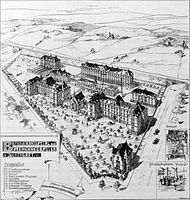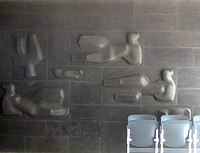Bürgerhospital (Stuttgart)
| Bürgerhospital (Stuttgart) | |
|---|---|
| Surname | Citizen Hospital |
| place | Stuttgart, Tunzhofer Str. 14-16 |
| Building | Hospital of the Stuttgart Clinic |
| Building history | Foundation: 1350/1366 Relocation to the Dominican Church : 1536 Old building: 1892–1894 Destruction in the war: 1944 New building: 1954–1959 |
| Architectural style | Old building: historicism |
| Client | City of Stuttgart |
| architect | Old building: Schmid & Burkhardt New building: Hans Herkommer and Jörg Herkommer |
| Coordinates | map |
The Bürgerhospital was a hospital in the Baden-Württemberg state capital Stuttgart and was run by the city itself. It belonged to the Stuttgart Clinic , in which the four city hospitals Katharinenhospital , Bürgerhospital, Olgahospital and Bad Cannstatt Hospital (including the women's clinic) have been merged since 1999 . In 2014, the Olgahospital and the women's clinic were integrated into the Katharinenhospital, and the Bürgerhospital followed by the end of 2015.
The Bürgerhospital specialized in internal medicine , neurology , geriatric medicine , psychosomatic medicine and psychotherapy . In 2012 it had more than 300 beds and treated almost 11,000 cases a year. In 2012, the staff consisted of 100 doctors and 185 nurses. It also served as an academic teaching hospital for the Eberhard Karls University of Tübingen .
The hospital emerged from the old hospital, which was rebuilt 1350-1366 and was named St. Catharina Hospital. In 1536 the hospital was moved to the Dominican monastery by the hospital church . In 1820 the hospital was renamed the Bürgerhospital. In 1894 the hospital moved into new buildings at its current location. After being destroyed in the war in 1944, it was rebuilt in 1954–1959. As part of the site concentration, it was gradually integrated into the Katharinenhospital (KH) and the Bad Cannstatt Hospital (kbc) from June 2015. At the end of December 2015, hospital operations in the Bürgerhospital were finally shut down.
The hospital has been part of the “ Dr. Klein ” can be seen as the Rosenstein Children's Clinic . The first season was broadcast on ZDF until January 2015, and the second season followed from October 2015. Filming for the third season began in spring 2016.
Range of services
The Bürgerhospital specialized in the following areas:
- Internal medicine with diabetology , endocrinology , hematology and oncology ,
- Neurology with Stroke Unit (stroke unit),
- Geriatric medicine
- and psychosomatic medicine .
The Center for Mental Health was moved from the Bürgerhospital to the Bad Cannstatt Hospital in 2012 .
In addition to inpatient care, the Bürgerhospital with several day clinics as well as outpatient advice and treatment offers offered individual options for diagnosis and therapy.
After the site concentration has been completed, the Stuttgart-Mitte treatment center with the following departments will remain in the Bürgerhospital at the previous location at Türlenstrasse 22 (Building 16a-c) of the former Center for Mental Health:
- Social psychiatric center for the treatment of chronically mentally ill people,
- Day clinic for the elderly
- Memory Clinic (memory consultation)
- Addiction medical day clinic
- and addiction medical outpatient clinic and counseling center.
The previous buildings 5 and 6 of the former psychiatry have been used as asylum accommodation since 2013. In the summer of 2015, asylum seekers also moved into the central bed building (House 2).
history
Old Hospital / St. Catharina Hospital
The forerunner of the community hospital was the old hospital at the upper gate. It was rebuilt around 1350 by Count Ulrich IV. , Later renovated by his wife Countess Katharina von Helfenstein and completed in 1366. The hospital was named St. Catharina Hospital after St. Catherine, its patroness. The hospital was designed to receive the poor, paying beneficiaries, and the sick.
Dominican monastery
After Duke Ulrich in Württemberg had pushed through the Reformation, the Dominican monastery at the Hospital Church was also secularized . In 1536 Duke Ulrich had the St. Catharina Hospital, later called the Bürgerhospital, relocated to the former Dominican monastery, where it remained until the new building was moved into in 1894.
Old building
In addition to the Bürgerhospital, there were other, partly hospital-like facilities in Stuttgart until the beginning of the 19th century, including the military hospital, the Seelhaus and the infirmary. These facilities were subordinated to the Bürgerhospital in 1813. Under the Support Residence Act of 1870, the city's poor system also had to be reorganized. The Bürgerhospital became an institution for the public welfare of the poor and had to guarantee the “care of poor, disabled, sick and stupid, predominantly elderly, frail people as well as for the care of mentally ill people of both sexes”.
In order to further implement the poor legislation, it was decided in 1889 to merge the community hospital, the poor buildings, the employment facility and the asylum for the homeless on the square between Tunzhofer Strasse and Wolframstrasse and the Gäubahn line. The architects Schmid & Burkhardt were entrusted with the planning. Construction began in May 1892 and was completed after only two years of construction in May 1894 with the inauguration. The spacious new hospital complex consisted of an infirmary (175 beds), a prayer room (chapel) and an old people's home (200 places), which together formed a building block at the site of today's building 2, and various administrative, supply and staff residential buildings. The hospital grounds included a park between Tunzhofer Strasse and today's Building 2, which still exists today in a different design, but with the old trees. In 1896 the “poor buildings” were completed, which offered space for over 500 people. From 1914 to 1916 the hospital was expanded to include buildings 5 and 6 for the neurological-psychiatric department.
New building
After the war destruction in 1944, the Bürgerhospital was rebuilt between 1954 and 1959 according to the plans of the architects Hans Herkommer and Jörg Herkommer . The new buildings included an internal clinic, a mental hospital, a geriatric clinic and a radiation clinic. There were also administration and supply buildings and, in 1965, a 15-story high-rise for hospital employees on Türlenstrasse.
The park between Tunzhofer Straße and Building 2, with its green spaces and solitary trees (beech, ginkgo, yew, linden, magnolia, plane tree, leather sleeve tree), which date from the construction of the old building, has been preserved as an attractive place to relax for patients and hospital employees.
architectural art
![]() Map with all coordinates of the section Kunst am Bau : OSM
Map with all coordinates of the section Kunst am Bau : OSM
| image | Artist | plant | year | Coordinates |
|---|---|---|---|---|
|
|
Max Verch (1897–1961) |
Reader
Semi-recumbent male figure at the pond, lawn between building 5 and building 6. Literature: #Hofmeister 1987 , page 92. |
1954 | map |
|
|
Lying patient
Lying patients, wall relief, building 2, entrance area. |
map | ||
|
|
Madonna
Madonna and Child, wall figure, above the entrance to the Tunzhofer Straße 15 building. |
map | ||
|
|
Three frail people
Three frail people, vertical wall relief, building 2, back. |
map | ||
|
|
Mother, son and daughter
Mother leads son and daughter, sheet metal silhouette surrounded by latticework, sickle-shaped overhead door above the entrance to Building A of the Center for Mental Health, Türlenstrasse 22A. |
map | ||
|
|
mother and child
Sculpture, to the left of Building A of the Center for Mental Health, Türlenstrasse 22A. |
map | ||
|
|
bird
Vogel, bronze sculpture, in the park in front of the main entrance of Building 2. |
map |
literature
- Description of the citizen hospital in Stuttgart. Stuttgart 1859.
- Albert Glück (editor): State capital Stuttgart, buildings 1970/85. Munich 1984, pages 76-77.
- Albert Glück (editor): State capital Stuttgart, buildings 1986/93. Munich 1994, page 33.
- Ludwig Krinn (editor): State capital Stuttgart, buildings 1994 - 2004. Munich 2004, page 46.
- Ilse Maria Hofmeister; Werner Schneider: Fountains, fountains and Brünnele in the Stuttgart area. Visited and photographed by Ilse Maria Hofmeister and Werner Schneider. With a greeting from Manfred Rommel and a foreword by Peer-Uli Faerber. Ludwigsburg [1987], page 92 (art in architecture, reader).
- Jörg Kurz: Northern history (s). About the dwelling and life of the people in the north of Stuttgart. 2nd edition, Stuttgart 2005, pages 161-164.
- State capital Stuttgart (editor): Bürgerhospital [600 years]. Stuttgart 1983.
- State capital Stuttgart (publisher): 100 years of the Bürgerhospital on Tunzhofer Strasse. Stuttgart 1994.
- Capital and residence city of Stuttgart. News about the new construction of the community hospital on Tunzhofer-Strasse. Published on the day of the grand opening May 1, 1894. Stuttgart 1894.
- Albert Pantle : The new civil hospital buildings in Stuttgart. In: Monthly of the Württemberg Association for Building Studies , year 1893, issue 4, pages 36–39.
- Karl Pfaff : History of the City of Stuttgart. Volume 2: History of the city from 1651 to 1845. Frankfurt am Main 1981, pages 437–445, especially 437 (“Spital”).
- Paul Sauer : History of the City of Stuttgart. Volume 2: From the introduction of the Reformation to the end of the 17th century. Stuttgart 1993, pages 121-125, 312-313 (hospitals).
- Paul Sauer : History of the City of Stuttgart. Volume 3: From the beginning of the 18th century to the conclusion of the constitutional treaty for the Kingdom of Württemberg in 1819. Stuttgart 1995, pages 202-209 (hospitals).
- Stadtverwaltung Stuttgart (editor): Festschrift for the 100th anniversary of the Katharinen Hospital in Stuttgart, January 9, 1928. Stuttgart 1928, pages 188–203, 204–207, especially 189–192, 204.
- Gustav Wais : Old Stuttgart. The oldest buildings, views and city plans up to 1800. With city history, architectural history and art history explanations. Stuttgart 1954, pages 81-82.
Web links
- Bürgerhospital on the homepage of the Stuttgart Clinic .
- Topographic map, hybrid map and aerial photos on a scale of 1: 500, city map Stuttgart , search term: Tunzhofer Straße 14.
Footnotes
- ↑ Website of the City of Stuttgart: To the Mitte location ahead of time ( Memento of the original from September 3, 2014 in the Internet Archive ) Info: The archive link was inserted automatically and has not yet been checked. Please check the original and archive link according to the instructions and then remove this notice. .
- ↑ #Klinikum 2013 , page [146-147]. - In 2012 the Center for Mental Health moved into the new building at Bad Cannstatt Hospital . This reduced the number of beds by around 300 and the number of cases by around 4,000.
- ↑ #Klinikum 2013 , pp. 140–141.
- ↑ "Dr. Klein" is back on duty / ZDF is shooting 13 new episodes (...) on presseportal.de
- ↑ Foreign Planet Germany: Team from “Dr. Klein "shoots with refugee children (August 27, 2016)
- ↑ #Klinikum 2014.1 , page 5, #Klinikum 2014.2 , page 12.
- ↑ #Klinikum 2014.2 , page 12.
- ↑ The Obere Tor stood at the northern end of the Breite Straße (formerly Obere Gasse).
- ↑ #Landeshauptstadt 1994 , page 64, #Wais 1954 , page 81–82.
- ↑ #Landeshauptstadt 1994 , page 65.
- ↑ #Landeshauptstadt 1994 , page 66.
- ↑ #Landeshauptstadt 1994 , page 39.
- ↑ #Landeshauptstadt 1994 , pp. 39–40.
- ↑ #Landeshauptstadt 1994 , pp. 41–42.
Coordinates: 48 ° 47 ′ 34.6 " N , 9 ° 10 ′ 46" E















